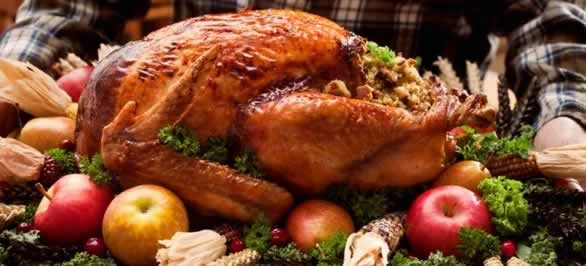
Paleontology on a platter . . . or IS it?!
By now the idea that birds represent the only surviving members of the once vast and diverse dinosaurian lineage has become common knowledge. Those dino nuggets on a toddler’s plate have more dinosaur in ‘em than we once thought, right? But a lot can happen to animal lineages during a 65-million-year span, so how dinosaurian was your Thanksgiving turkey after all?
- At the heart of the argument, or at least the chest, we have the all-important wishbone. Up until the past 50 years, scientists thought wishbones (furculae) occurred only in birds. The apparent absence of a wishbone or even collarbones (clavicles) in dinosaurs disqualified them as bird ancestors for most scientists. Better discoveries and changing theories have led scientists to reconsider previous identifications, and they have identified wishbones in several theropod dinosaurs. Though describing all the ins and outs of what they mean for deducing evolutionary relationships, possible functions, and their origins here would prove too furculean (har har) a task to cram in here, a few details should help clear up what this means for turkeys and dinosaurs. The wishbone in a turkey gets its shape because, among other functions, it may act as a spring during the flight stroke. As such, birds with different styles of flight show variations on the basic keeled U-shape with rod-like branches. Dinosaur wishbones, however, generally form a V-shape and appear in many cases built to resist bending like a bird’s wishbone. If you were to break a Tyrannosaurus rex’s wishbone with someone, for example, you’d need some hydraulic machinery: it’d take nearly 3 tons of force to snap it.
Scorecard: theropod dinosaurs and modern birds are the only animals known to have wishbones, but they used them in completely different ways.
- Speaking of which, birds and other theropods exhibit radically different shoulder designs. This should come as no surprise, seeing as how modern birds descend from an airborne ancestor. The design curve for achieving bird-style flight evidently took some time: even early birds like Archaeopteryx exhibit a more dinosaur-like shoulder, though they had achieved powered flight. Dinosaurian theropods like Velociraptor or Allosaurus, on the other hand, exhibit much less flexibility in their forearms. In fact, while dinosaur books seem fond of mentioning that T. rex arms could not reach its mouth, this isn’t unusual for a carnivorous dinosaur: Velociraptor and Allosaurus were equally incapable of sticking stuff into their mouths with their hands, thanks to their shoulder and elbow designs.
Scorecard: as Thanksgiving sometimes proves, belonging to the same lineage doesn’t necessarily translate to anatomical or behavioral similarity. Turkeys have some very undinosaurlike features, including their shoulders.
- Birds employ a unique respiratory system. Their lungs don’t actually expand, and air only flows through them in one end and out the other. The organs that pump air in and out line sections of the torso and, in some cases, invade the bones of the neck, shoulders, and near the hips. While we don’t know exactly how dinosaur lungs functioned, the bones of theropods and—strange to say—the long-necked sauropods show that they had air sacs. This ups the chances that they had respiratory designs that at least resembled birds’ to some degree. Oddly, the bird-hipped dinosaurs lack any such evidence, so their lung structure remains a big question mark.
Scorecard: that we find similar structures in animals that look so radically different as brontosaurs and birds strengthens the case that they belong to the same lineage in one way or another.
- Obviously, there’s more to the story than three anatomical points. Much more. Let’s make this a yearly tradition, shall we? That way we can cover other facets of the bird-dinosaur relationship. For now, consider this: the answer depends greatly on the analysis techniques you use. Phylogenetic arguments—that is, describing an animal by its relationships with other species—clearly place birds in the dinosaur group, just as cows are mammals and dinosaurs themselves are reptiles (so yes, in a sense you ate reptile for Thanksgiving dinner) and the whole lot of them are tetrapods. On the other hand, birds exhibit some important differences from classic dinosaurs, prompting scientists to sometimes describe them as avian dinosaurs (birds) and non-avian dinosaurs (um, dinosaurs . . .). Those differences have been developing since birds diverged from the other dinosaur groups 150 million years ago. They allowed birds to survive the extinction events that kicked off the age of mammals when other dinosaurs didn’t. In other words, if birds were dinosaurs in a practical sense, they’d be just as extinct as the rest of them. Calling them a type of living fossil may not make as much sense as the phylogenetics may imply. It mainly depends on your point of view. ‘Til next year!
—Jeff Bond
Works cited: Lipkin, C., & Carpenter, K. (2008). Looking again at the forelimb of Tyrannosaurus rex. Tyrannosaurus rex, the tyrant king, 166-189.
Carney, Ryan M. (2016). Evolution of the archosaurian shoulder joint and the flight stroke of Archaeopteryx. Journal of Vertebrate Paleontology, Program and Abstracts, 2016, 110.
